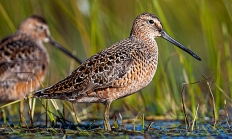Search myodfw.com
This large brown shorebird is the most wide-ranging of the curlew species. It is distinctive, having contrasting light-brown and dark-brown head stripes and a long decurved bill that it uses to probe for food on coastal mud flats and beaches. It is a common spring and fall migrant in coastal areas although it is also found, rarely, in small numbers inland as well. It is a rare spring migrant in the Willamette Valley with generally about one record annually, typically in late April or early May. Hear the call of the Whimbrel Photo by ©Keith Kohl, ODFW

The Long-billed curlew is the largest North American shorebird. Its most striking morphological characteristic, the long decurved bill, is an adaptation for foraging on earthworms or burrow-dwelling organisms like shrimp and crab. Body plumage is a rich buff with a tinge of cinnamon or pink. Sexes have similar plumage, but females are larger with a longer bill. It can be distinguished from other curlews in flight by its bright cinnamon underwings. When observed on the ground, the Long-billed curlew's head lacks the strongly streaked pattern of other cerlews or Whimbrel. It is a locally common breeder in open grassland areas

A large, long-legged wader distinguished from similar species in a flight by flashing rufous underwings and dark brown primaries. Its feet extend beyond tail tip in flight. Flocks generally consist of fewer than 50 birds on the coast. Juveniles migrate south several weeks later than most adults. After mid-November, a few stragglers are seen until late December. The Marbled godwit is a regular spring and fall migrant on the Oregon coast. Spring migration commences in early April and extends through early June on the coast. Its average arrival at the Malheur National Wildlife Reserve is April 27. Hear the call

The noisy and frenetic Ruddy turnstone is a stocky, plover-like bird who's breeding plumage is a clown like pattern of black, rust and white. Ruddy turnstones have been found foraging in the company of many other shorebird species. Found on rocky shores, jetties, open ocean beaches, mud flats, salicornia marshes, grass flats and flooded fields, the Ruddy turnstone is an opportunistic feeder. It is an uncommon to common spring and fall transient along the coast; a few birds remain to winter there each year. The largest flocks are seen during spring and fall migration at Bandon. They are an irregular

Along coastal shores and islands, the chatter and flight calls of Black turnstones invite an observer to look more closely at the rocky substrates to find these birds busily picking about in their search for food. They primarily use rocky shores, jetties, and offshore islands, but may also be found on shorebird flats and sandy beaches. The Black turnstone is a common transient and winter visitant on the coast. Hear the call of the Black turnstone Phogo by ©Keith Kohl, ODFW

This stocky, medium-sized shorebird is a denizen of Oregon's rocky shoreline, foraging as close to the crashing waves as possible, hence its name. It uses the rocky intertidal zone which includes jetties, offshore rocks and rocky shorelines, sea stacks, and tidal pools and is occasionally found on sandy beaches interspersed with groups of rocks, and on mudflats near the mouth of the Coquille River. It sometimes uses freshwater outfalls for bathing. Birds wintering in Oregon have the upperparts, head, neck, and breast slate gray with a whitish eye-ring. Indistinct supercilium and chin are white, wheres the belly and abdomen are

These stocky shorebirds stand out among their fellow migrants in spring, resplendent with rich rufous breasts shading into white on the lower belly. Red knots have short, black bills tapering to a fairly fine tip; short legs give them a low-slung appearance. They are highly gregarious and tend to form tight foraging and roosting flocks. Found primarily on the coast, they are regular transients in spring and fall. Knots forage on open estuarine tide flats, less commonly on margins of sand ocean beaches. Inland, they are found on margins of sewage ponds and at large brackish lakes such as Malheur
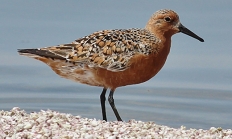
These small gray-and-white sandpipers are commonly seen on beaches from early fall through late spring running in and out along the surf's edge. Buffier, spangled juveniles can be seen in late summer but the stunning rufous breeding plumage is less often seen and can be starling and confusing. The larger size, larger bill, and different habits of the Sanderling help distinguish it in all plumages from other small sandpipers. It is common to locally abundant on open sand beaches from fall through spring. Statewide, it is a rare to locally uncommon migrant inland, most often reported along the Columbia River
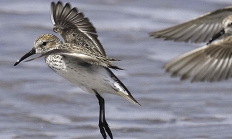
This tiny sandpiper is the rarest of the regularly occurring "peeps" in Oregon. Only a handful of individuals are reported in Oregon each year, mostly during fall migration and usually in mixed flocks with Least and Western Sandpipers. Like the Western sandpiper, the Semipalmated has black legs, but its bill is generally shorter, straighter and more blunt. Well-known as a transoceanic migrant, the Semipalmated sandpiper may be one of the fastest flying of the long-distance shorebirds. It is a rare irregular spring transient throughout Oregon, and a very uncommon coastal and rare inland fall transient. It is usually found inside
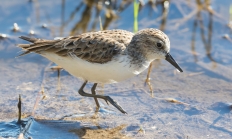
At certain estuaries and interior alkali lakes, flocks of many thousands of these migrants can be observed swirling around over shallow water, landing to frantically feed, before resuming migration. Falcons often attack Westerns, and their acrobatic, tightly coordinated escape flights are breathtaking to observe. In winter, these small sandpipers are gray above with white underparts. In breeding plumage they have a rich rufous-chestnut back, cheeks and cap, dark-centered scapulars with rufous-chestnut edges, grayish throats streaked with dark chevrons through the flank, and whitish underparts. Longer-billed females generally are larger than males but are otherwise similar in appearance. Along the coast

This is the world's smallest "peep" and can usually be picked out by its brownish coloration, dull yellowish legs, and hunched, creeping foraging style. Least can be found in small flocks in Oregon almost year-round. The Least sandpiper feeds on open mud with Western sandpipers but often feeds where some grass, salicornia or other cover is present, avoiding walking in the water as Western often do. It is uncommon to locally abundant statewide in migration, with most birds along the coast and at larger lakes and marshes inland. It is locally common on the coast in winter; smaller numbers winter

These large "peeps" are seen in Oregon mainly in late summer and fall, when their size, scalloped buffy plumage, and long profile help them stand out in flocks of other small sandpipers. It is an uncommon migrant statewide, with most birds southbound juveniles. It can occur in suitable habitat anywhere in Oregon, but numbers are usually very low and sizable flocks almost nonexistent. Hear the call of the Baird's sandpiper Photo by Howard Patterson, Flickr

These brownish, heavily streaked, medium-sized shorebirds are often seen peering over grass in the more overgrown parts of mudflats, especially in fall. It is found statewide in migration; largest numbers in fall, and it is sometimes all but absent in spring. It is common on the outer coast but also in wet coastal pastures. They are more local inland but large flocks can be found in preferred habitat. Hear the call of the Pectoral sandpiper Photo by Jason Crotty, Flickr
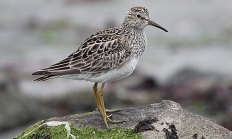
This is a portly, brightly colored shorebird, typically found in coastal salt marshes, mud flats, and sandy margins of freshwater ponds. Migrant juveniles rather than adults appear in Oregon. They have a flattish, dark rufous-colored crown with fine black streaking. The crown gives the appearance of a jaunty "cap" sitting forward on the head and abruptly ending at the rear. The breast is rich orange-buff shading into the white lower breast and belly. The well-defined creamy-white supercilium broadens behind the eye and is visible at a considerable distance. This is one of the most distinctive field marks on juveniles. They
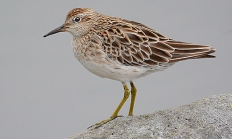
This medium sized, stocky sandpiper is rarely observed away from the rocky coastline as it forages close to the zone of salt spray. Primarily a late fall migrant with the major influx into Oregon occurring the last week in October and into early November. Generally silent during migration and on wintering grounds. Often found singly or in small groups with foraging Black turnstones and Surfbirds. Cryptic plumage makes it difficult to observe as it forages slowly over mussel and barnacle beds in typical sandpiper fashion. Roosts on rocks with Black turnstones and Surfbirds near feeding grounds, just above the spray

The Dunlin undergoes one of the most dramatic changes in appearance of all shorebirds when it molts from winter to breeding plumage. In winter, these medium sized sandpipers are brownish gray above with white underparts, but in breeding plumage they have a striking rufous-brown back and cap and black belly. Females are larger than males but otherwise similar in appearance. The Dunlin is an abundant transient and winter visitant in estuaries and occasionally on beaches along the coast of Oregon, but significant numbers winter in the Willamette Valley, especially the southern part. Hear the call of the Dunlin Photo by
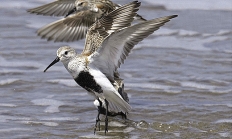
This slender sandpiper is a rare but nearly annual visitor to Oregon. Although easily overlooked, its drooped bill, light eyeline, long neck, long greenish legs, and unstriped wings in flight help set this medium-sized shorebird apart from similar species. Its preferred habitat during migration is shallow freshwater, usually avoiding mudflats and beaches. It feeds on invertebrates such as midge, beetle and mosquito larvae. A rare fall and occasional spring transient, it is most frequently found in estuarine habitat along the coast. It is also found along the shorelines of the Great Basin region. Hear the call of the Stilt sandpiper
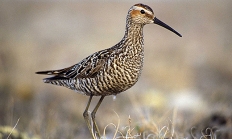
The Buff-breasted sandpiper resembles a plover with a high-stepping, pigeon-like gait. One of the few Oregon shorebirds that frequents dry, sparsely vegetated coastal grasslands. Fall migrants consist of juveniles. It has scaly, buffy-brown underparts, yellow legs, a small head, and a short black bill. Beady black eyes stand out on a plain, pale face. It bobs its head while moving. Gleaming white underwings are displayed in a graceful flight pattern. It is unique among North American shorebirds in having a lek mating system. This is a rare but regular fall migrant on the Oregon coast where it has been recorded
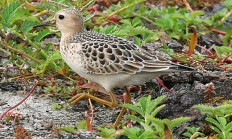
The male Ruff is a relatively large, distinctive, Eurasian shorebird that in breeding plumage sports head tufts and neck plumes from which it gained its name. However, most Ruffs seen in Oregon are juveniles that appear as lanky, buff-colored, pot-bellied, short-billed sandpipers showing white on both sides of the rump in flight. Females are about 20 percent smaller than males and are referred to as reeves. It is usually found on mudflats of coastal estuaries and adjoining wet meadows. The Ruff takes mostly aquatic insects, but will take crustaceans, mollusks, and some worms as well. The Ruff is a rare
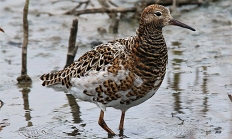
These chunky medium-small shorebirds are quite colorful in oranges and browns during most of their time in Oregon, where they are found mainly along the coast and locally in muddy areas inland. Their feeding motion has been likened to a sewing machine as flocks move slowly through shallow water and wet mud, probing with long straight bills. They are occasionally seen in marginal areas such as flooded pastures, but less likely than Long-billed to use such upland locations. They are a common to locally abundant coastal migrant, less common and more local in western interior valleys, and rare bur regular
